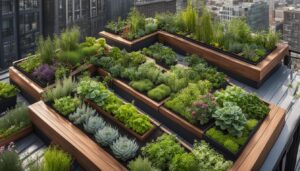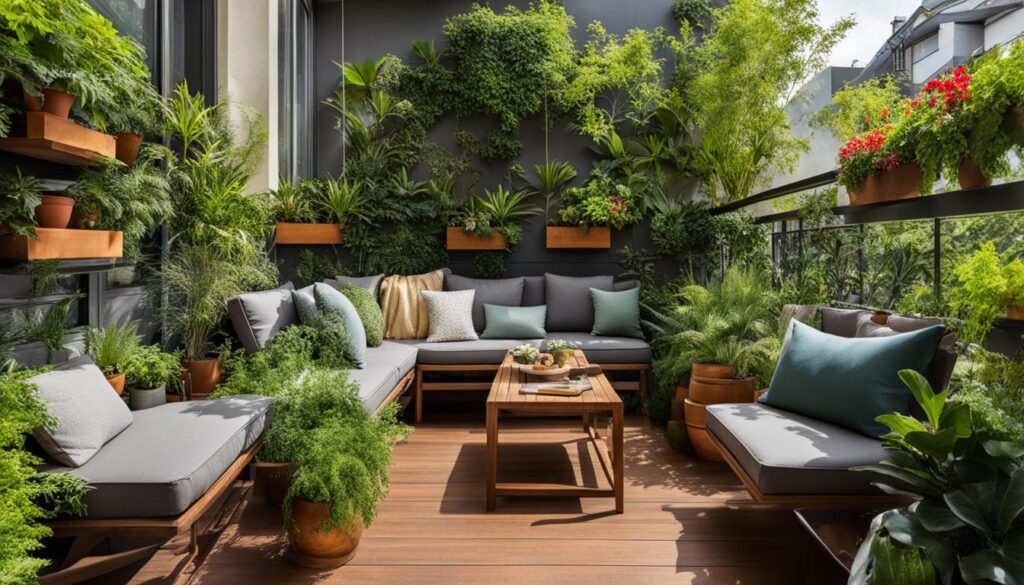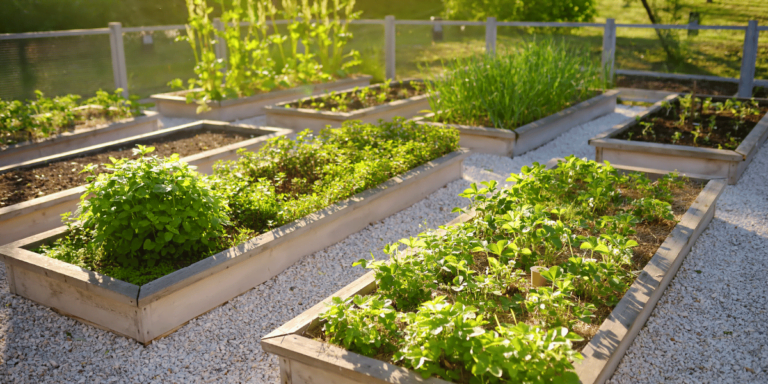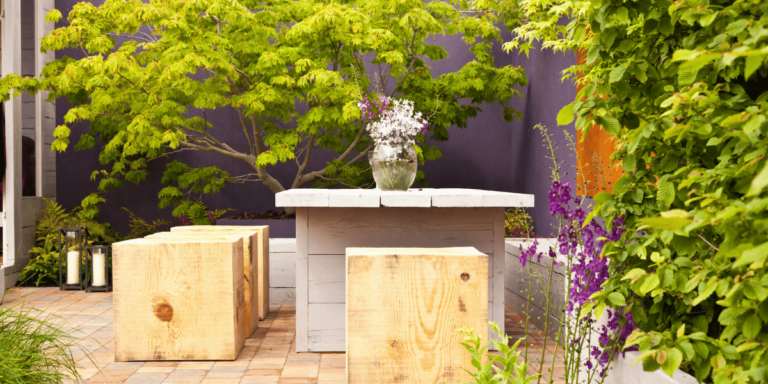Urban gardening has become a popular way to create sustainable and eco-friendly environments in city spaces. With a focus on sustainable urban gardening and eco-friendly landscape design, urban garden designs are transforming concrete jungles into vibrant and green havens.
These innovative designs prioritize water conservation techniques and the integration of renewable energy in eco-gardens, making them a key tool in creating a greener and more environmentally-friendly city environment.
By implementing these designs, you can create stunning urban gardens that not only enhance the aesthetic appeal of city spaces but also contribute to a healthier and more sustainable future.
Key Takeaways:
- Urban garden designs focus on sustainability and eco-friendliness.
- Innovative water conservation techniques are integrated into these designs.
- Renewable energy plays a crucial role in eco-gardens.
- Urban gardens enhance the aesthetic appeal of city spaces.
- They contribute to a greener and more environmentally-friendly city environment.
Container Gardening: Small Spaces, Big Impact
Container gardening is a versatile and low-maintenance method of urban gardening that is perfect for small spaces. It allows you to grow plants in pots, buckets, or upcycled containers, making it easy to move them around to catch sunlight or avoid harsh weather conditions. Container gardening requires less watering and weeding compared to traditional gardening methods, making it an ideal choice for urban dwellers with limited space. With container gardening, you can maximize the greenery in your city space and create a beautiful urban garden.
One of the main advantages of container gardening is its versatility. Whether you have a balcony, rooftop, or small backyard, you can create a vibrant garden with containers. This method also offers flexibility in plant selection, as you can grow various flowers, herbs, vegetables, or even dwarf fruit trees in containers.
Container gardens are not only visually appealing but also practical. They can be easily rearranged to change the layout or accommodate new plants. This flexibility allows you to experiment with different designs and create a unique urban oasis tailored to your preferences.
Benefits of Container Gardening
Container gardening offers numerous benefits for urban gardeners:
- Space conservation: Containers can be placed on balconies, patios, or even windowsills, making it possible to garden in even the smallest spaces.
- Portability: Containers allow you to move your plants to optimize sunlight exposure or protect them from extreme weather conditions.
- Easy maintenance: Container gardens require less watering and weeding than traditional gardens, making them ideal for people with busy lifestyles.
- Protection from pests: Elevating plants off the ground can help reduce the risk of pests and diseases.
- Accessibility: Container gardens can be designed at a convenient height, making it easier for people with physical limitations to enjoy gardening.
By utilizing containers, you can create stunning displays of flowers, herbs, and vegetables that add vibrancy to your urban environment. So, whether you have a tiny balcony or a small backyard, container gardening is a fantastic way to bring nature into your city space.
| Container Gardening Tips | |
|---|---|
| Choose the right container size: Ensure containers have enough room for the root system of your plants. | |
| Use high-quality potting soil: Opt for well-draining soil specifically formulated for containers. | |
| Water appropriately: Containers may require more frequent watering, especially during hot summer months. | |
| Fertilize regularly: Supplement the nutrients available in the potting soil with a balanced fertilizer. | |
| Consider companion planting: Grow compatible plants together to maximize space and benefit from natural pest control. | |
| Monitor sunlight exposure: Place containers in areas that receive adequate sunlight for the specific plants you are growing. | |
| Prune and deadhead: Regularly trim and remove spent flowers to encourage continuous growth and prolong blooming. |
Vertical Gardening: Reaching New Heights
Vertical gardening is an innovative urban gardening method that maximizes available space. With limited ground areas in urban environments, vertical gardening offers a practical solution to create thriving gardens. By utilizing walls, trellises, and hanging baskets, you can transform your urban space into a lush green paradise.
One of the key advantages of vertical gardening is its space-efficient nature. Instead of sprawling horizontally, plants are grown vertically, making use of the often-neglected vertical space. This allows you to cultivate a wide variety of plants in a small footprint, perfect for urban dwellers with limited gardening space.
Vining or climbing plants are particularly well-suited for vertical gardening. These plants have a natural tendency to grow upwards, making them ideal for creating a stunning vertical display. Some popular climbing plants for vertical gardens include tomatoes, cucumbers, and beans. These plants not only add a touch of greenery but also provide a bountiful harvest.
Vertical gardening not only saves space but also adds visual interest to your urban environment. Picture a wall covered with cascading vines, blooming flowers, or lush green foliage. It’s a sight that invites relaxation and provides a refreshing change from the concrete jungle.
To help you visualize the beauty of vertical gardening, take a look at the image below:
As you can see, the vertical garden showcases the potential of transforming bare walls into vibrant greenery. By harnessing the power of climbing plants and space-efficient gardening techniques, you can create a striking visual display while optimizing space.
Benefits of Vertical Gardening:
- Space Optimization: Vertical gardening maximizes available space, making it ideal for small urban environments.
- Enhanced Aesthetics: Vertical gardens add beauty and visual interest to otherwise mundane walls.
- Bountiful Harvest: Vining plants provide a plentiful harvest, allowing you to enjoy homegrown produce even with minimal space.
- Improved Air Quality: Plants in vertical gardens contribute to cleaner air by absorbing carbon dioxide and releasing oxygen.
- Reduced Environmental Impact: Vertical gardening promotes sustainable practices by utilizing space efficiently and reducing the need for synthetic fertilizers and pesticides.
With vertical gardening, you can transform your urban space into a thriving garden that reaches new heights, both literally and figuratively. With careful planning and a touch of creativity, you can create a lush and vibrant urban oasis that captivates the senses and makes the most of limited space.
Balcony Gardening: Your Personal Urban Oasis
Balcony gardening is a popular urban gardening method that transforms balconies into lush garden oases. With limited space in urban areas, balcony gardening offers a creative solution for those who want to enjoy the beauty of nature in their private outdoor space. By implementing smart design strategies and selecting the right plants, you can create a vibrant and relaxing sanctuary right on your balcony.
Small Space Urban Garden Designs
One of the key advantages of balcony gardening is that it allows you to garden in small spaces. Whether you have a cozy apartment balcony or a spacious rooftop terrace, you can maximize the available space by using vertical gardening techniques and compact plants. By choosing plants that naturally stay small or can be pruned to maintain a compact size, you can create a lush garden without overwhelming your balcony.
Consider incorporating multi-level plant stands or railing planters to maximize vertical space. These clever solutions allow you to layer different plants and create a visually appealing garden design. You can also use hanging baskets to add a charming touch to your balcony garden and make use of unused overhead space.
Compact Plants for Balcony Gardening
When selecting plants for your balcony garden, opt for varieties that are well-suited to small spaces. Herbs like basil, thyme, and mint are excellent choices, as they can be grown in small pots and add delightful fragrance to your balcony. Dwarf fruit trees, such as compact apple or citrus trees, are also great options for balcony gardening.
In addition to herbs and fruit trees, consider incorporating ornamental plants that are naturally compact. Some popular choices include dwarf roses, ornamental grasses, and colorful annual flowers like petunias and marigolds. These plants will bring color and beauty to your balcony while fitting perfectly within the limited space.
Automated Watering for Easy Maintenance
Maintaining a balcony garden can be made easier with automated watering systems. Self-watering containers are a convenient option, as they provide the right amount of water to plants without the need for constant monitoring. These containers have built-in reservoirs that gradually release water to the plants, ensuring they stay well-hydrated even if you’re away for a few days.
Alternatively, you can install a drip irrigation system to automate watering across your balcony garden. This system delivers water directly to the plant roots, minimizing wastage and ensuring efficient irrigation. With automated watering systems, you can enjoy your balcony garden without the stress of daily watering.
| Pros of Balcony Gardening | Cons of Balcony Gardening |
|---|---|
| – Utilizes limited space efficiently – Provides a private outdoor oasis – Easy access to fresh herbs and greens | – Limited room for large plants or trees – Requires careful consideration of weight load – Possible shading from surrounding buildings |
Overall, balcony gardening offers a wonderful opportunity to create a personal urban oasis. With the right plant selection, space-saving techniques, and automated watering systems, you can transform your balcony into a thriving green retreat. Enjoy the tranquility and beauty of nature right outside your doorstep with balcony gardening.
Urban Permaculture: Sustainable City Gardening
Urban permaculture is a revolutionary approach to gardening in the city. It combines ecological principles and innovative techniques to create self-sustaining ecosystems that are both beautiful and environmentally friendly. By observing and interacting with the urban environment, urban permaculture seeks to mimic the resilience and diversity of natural ecosystems.
One of the key elements of urban permaculture is ecological gardening. This approach focuses on working with nature rather than against it. It involves using organic and natural methods to create a healthy and balanced garden ecosystem. Practices such as composting, companion planting, and water harvesting help reduce waste, conserve resources, and promote biodiversity.
Sustainable gardening is another crucial aspect of urban permaculture. By adopting sustainable practices, such as using organic fertilizers, conserving water, and minimizing chemical inputs, urban gardeners can minimize their environmental impact and promote long-term resilience in their gardens. Sustainable gardening not only benefits the environment but also improves soil health and plant vitality.
By implementing urban permaculture principles, you can create vibrant and productive urban gardens that not only provide food and beauty but also contribute to the regeneration of our urban landscapes. Whether you have a small balcony or a spacious backyard, urban permaculture offers creative solutions and a holistic mindset that can transform your city space into a thriving and sustainable oasis.
Frequently Asked Questions
What is container gardening?
Container gardening is a method of urban gardening that involves growing plants in pots, buckets, or upcycled containers instead of traditional garden beds. It is ideal for small spaces and allows for easy mobility and manipulation of plants.
What are the advantages of container gardening?
Container gardening requires less watering and weeding compared to traditional gardening methods. It is also versatile and low-maintenance, making it a convenient option for urban dwellers with limited space.
What is vertical gardening?
Vertical gardening is an innovative urban gardening method that utilizes vertical space by growing plants on walls, trellises, or hanging baskets. It is an effective way to maximize available space and create visually stunning gardens.
What types of plants are suitable for vertical gardening?
Vining or climbing plants like tomatoes, cucumbers, and beans are perfect for vertical gardening as they can grow upwards and make use of the vertical space. They create cascading greenery and add visual appeal to urban gardens.
What is balcony gardening?
Balcony gardening is a popular urban gardening method that transforms balconies into lush garden oases. It involves choosing compact plants, utilizing multi-level plant stands or railing planters, and implementing automated watering systems for easy maintenance.
What are some examples of compact plants for balcony gardening?
Compact herbs, dwarf fruit trees, and ornamental plants are suitable choices for balcony gardening as they won’t overcrowd the limited space. They add beauty and provide a connection with nature in private outdoor areas.
What is urban permaculture?
Urban permaculture is a sustainable and regenerative approach to urban gardening that mimics natural ecosystems by integrating elements like composting, water harvesting, and diverse plantings. It creates self-sustaining and resilient urban gardens.
How does urban permaculture contribute to sustainable city living?
Urban permaculture incorporates ecological principles and creates balanced and self-sustaining systems in urban gardens. It promotes biodiversity, reduces waste, conserves water, and contributes to a more sustainable and eco-friendly city environment.













